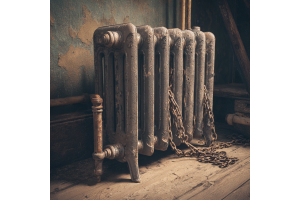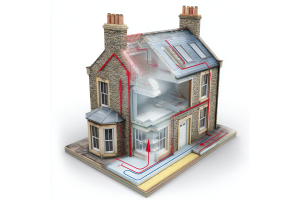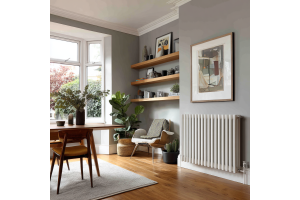
Radiator installation may sound like a job best left to a professional, but with the right tools, a bit of patience, and a clear step-by-step guide, it’s entirely possible to tackle it yourself. Whether you're replacing an outdated unit or adding a modern radiator to a new room, this comprehensive guide will help you install it safely and efficiently.
Note: If your project involves major plumbing work or modifying your boiler system, it's always wise to consult a Gas Safe registered professional.
Tools & Materials You'll Need
Before starting, gather the following tools and materials:
Tools:
-
Adjustable spanner or wrench
-
Pipe cutter or hacksaw
-
Tape measure
-
Pencil
-
Drill & wall plugs
-
Pipe wrench
-
Spirit level
-
Radiator key
-
PTFE tape (plumber’s tape)
-
Bucket & towels (for draining)
Materials:
-
New radiator
-
Brackets (usually included)
-
Radiator valves (manual or thermostatic)
-
Copper or plastic pipe (if repositioning)
-
Wall plugs & screws
-
Radiator bleed valve
-
Inhibitor solution (recommended)
Pre-Installation Checks
1. Turn Off the Heating System
Ensure your boiler and heating system are off. Let the water in the system cool completely to avoid burns.
2. Drain the System
Locate the drain valve at the lowest point of your central heating system and use a hose to drain the water into a bucket or outside. Open bleed valves on radiators to help the system drain faster.
3. Measure Your Space
Measure the height and width of the area where your radiator will go. Check pipework positions and clearance from the floor (typically 100–150 mm) to allow airflow and cleaning access.
Step-by-Step Radiator Installation Guide
Step 1: Remove the Old Radiator (If Applicable)
-
Place towels and a bucket under the radiator.
-
Use an adjustable spanner to disconnect the radiator valves.
-
Gently lift the radiator off the brackets (you may need help—it can be heavy).
-
Drain any remaining water from the old radiator and safely dispose of or store it.
Step 2: Mark Wall Bracket Positions
-
Use a spirit level to ensure your radiator will be straight.
-
Mark bracket positions on the wall with a pencil based on your radiator’s dimensions.
-
Double-check measurements—especially the distance between bracket centers and pipe inlet positions.
Step 3: Install Wall Brackets
-
Drill into the marked points using the correct size for your wall plugs.
-
Insert the plugs and secure the brackets with screws.
-
Check for level alignment again before mounting the radiator.
Step 4: Fit the Radiator Valves
-
Wrap PTFE tape around the valve threads to prevent leaks.
-
Attach your thermostatic radiator valve (TRV) and lockshield valve to the radiator.
-
Tighten with an adjustable spanner—but don’t overtighten as this can damage threads.
Tip: Always install the TRV on the flow side (incoming pipe), unless your valve is bi-directional.
Step 5: Mount the Radiator on the Wall
-
Carefully lift the radiator and hook it onto the brackets.
-
Make sure it’s securely mounted and aligned horizontally.
-
Connect the valves to the existing pipework and tighten the compression nuts.
If the pipework doesn’t match, you may need to adjust it using elbows, couplers, or flexi-pipes.
Step 6: Fill & Bleed the System
-
Close all bleed valves and the drain valve.
-
Refill your heating system slowly via the boiler’s filling loop. Monitor pressure (aim for ~1.5 bar).
-
Once filled, bleed each radiator starting with the one closest to the boiler. Use a radiator key to release air until water flows out steadily.
-
Recheck the pressure and top up if necessary.
Step 7: Test Your New Radiator
-
Turn your boiler and heating system back on.
-
Allow time for the system to circulate water and heat up.
-
Check for leaks at valve connections.
-
Ensure your radiator is heating evenly from top to bottom.
Finishing Touches
-
Paint Touch-Ups: If the wall was marked or scratched during the process, patch it up with paint.
-
Add Inhibitor: It’s good practice to add a corrosion inhibitor to your heating system to protect your new radiator and pipes.
-
Secure Pipework: If you’ve added any new pipes, make sure they are clipped and supported securely.
Additional Tips for a Professional Finish
-
Choose the right BTU output for the size of the room—underrated radiators will struggle to heat the space.
-
Vertical radiators are great space savers in kitchens, hallways, or narrow rooms.
-
Consider designer or coloured radiators to blend with or enhance your decor.
-
Add smart thermostatic valves to automate and control heating room-by-room.
When to Call a Professional
You can tackle this job yourself, but call a certified plumber or heating engineer if:
-
You’re installing new pipework or relocating your radiator far from the original location.
-
Your system requires draining and flushing.
-
You're unfamiliar with boiler safety or the installation includes electrical components.
Conclusion: A Satisfying DIY Upgrade
Installing a radiator by yourself can be a rewarding project that not only saves you money but also gives you more control over your home’s heating and design. With careful preparation, the right tools, and a step-by-step approach, even beginners can succeed.
However, safety should always be your top priority. If you ever feel unsure or face unexpected issues, don’t hesitate to consult a professional. In the end, a properly installed radiator is a long-term investment in comfort, efficiency, and style.







